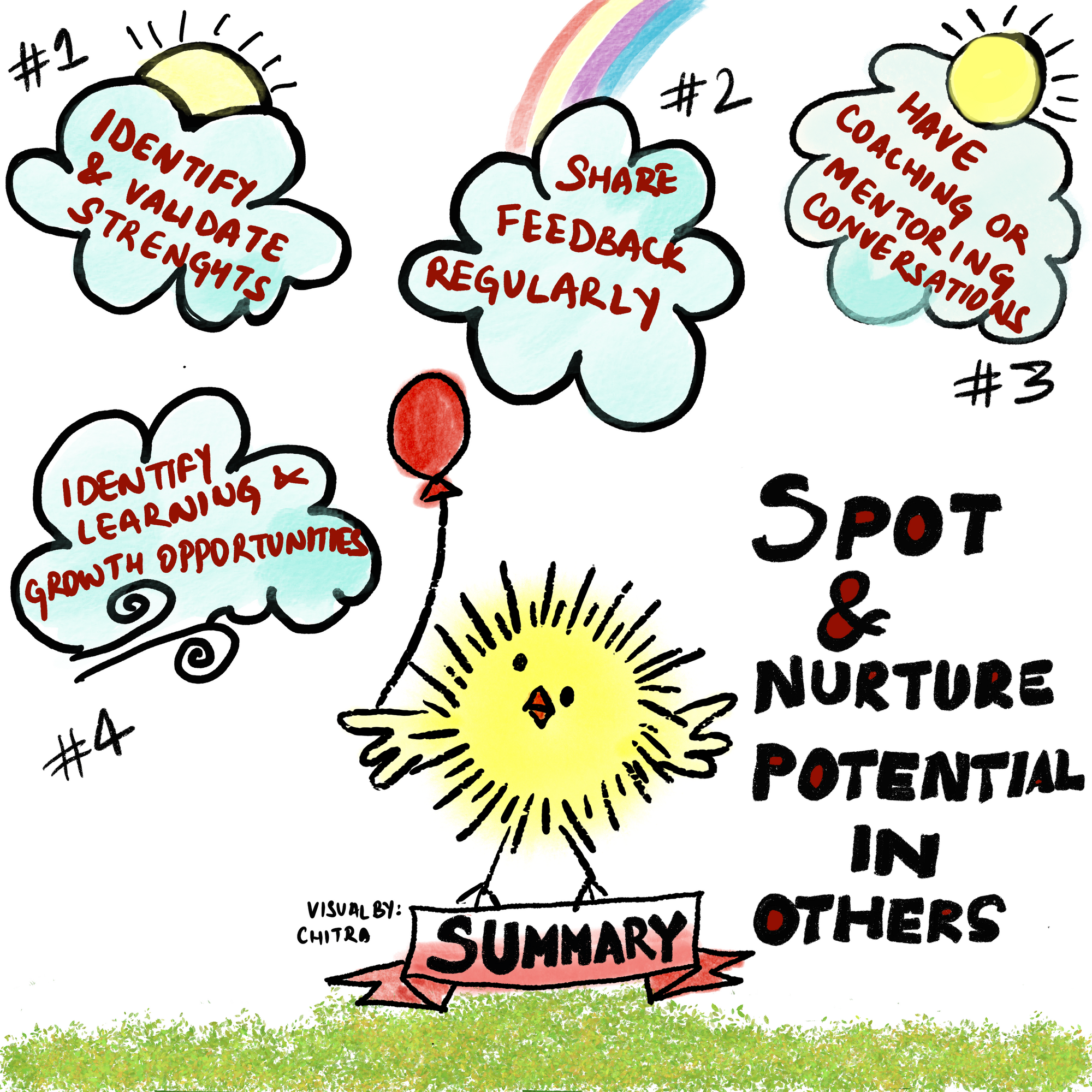How to spot & nurture potential in others
What it means to spot & nurture potential in others.

At ThoughtWorks we believe that spotting & nurturing potential in team members is a natural part of any leader’s work. And in a culture of cultivation, this applies to all team members as well, where they find ways to do this for each other as part of their everyday work & beyond.
Helping your team members grow by spotting their strengths / potential & supporting them to develop those, doesn’t always require structured or formal interventions, although there is a place for those too. It can happen as part of everyday conversations and work activities.
In this post, we share some such ideas to spot & nurture potential in your team members. While this is addressed primarily to team leads, much of it can be applied by all team members as well.

I. Identify & validate strengths
While there are some tools out there that you can use to identify strengths for a person, the best way to do it is simply through everyday observation. Observe them in various work situations and figure out what they seem to be consistently good at. This can include:
- Craft skills (story writing, setting up testing infrastructure, creating powerful UX designs etc)
- Soft skills (presentation skills, persuasion skills, listening, conflict resolution)
- Amplifying skills or meta skills that amplify the impact of all the other skills ( strong communication, high self awareness, ability to learn fast, influencing skills etc)
There is no hard & fast rule to this classification, the idea is to spot a range of strengths or potential strengths in the person.
While some strengths may be easy to spot because they show up in everyday work, others may be harder because the person may not have the opportunity to demonstrate them within their daily work boundaries. One way to tackle this is for the team members to rotate some responsibilities as much as possible. For example a showcase doesn’t always have to be run by the Business Analyst (BA), other roles can facilitate it as well. Likewise retrospectives, client calls, stand ups & team planning meetings can be facilitated by various roles within the team. This allows everyone to both learn new skills and discover what else they like & are good at, besides their core role / craft skills.
Also, team members can take on some bits of other team member’s roles from time to time. For example, developers may craft a story or two while the BA may write a piece of code. This expands the team’s collective skill base while creating a contingency cushion in case specific team members aren’t available for some reason. This is also how many people have changed roles in the past at ThoughtWorks, when they have realised that they were better at something other than their core role and subsequently gone on to be highly successful.
Once you have some hypothesis about a person’s strengths & potential through observation, it’s important to also validate your hypothesis through conversations. Discuss your observations with the team member and check with them what they think about that. Sometimes they may not even realise that they are demonstrating a potential strength and it may take them some time to internalise that & own it up.
If you are keen to use structured tools to have strengths conversations with someone, check out our previous post - Strengths based approach.
II. Share feedback regularly
Feedback is one of the most powerful tools you can use for helping someone grow. Give feedback to your team members frequently to reinforce strengths & redirect for improvement. This is especially useful when the team member already has clear learning goals. This simple practice can accelerate people’s growth significantly.
As ThoughtWorkers, we have a tendency to focus much more on improvement areas and ignore, underestimate or even dismiss reinforcing positive feedback. We believe this happens due to our high standards & relentless pursuit of excellence. So we consider it crucial to keep reminding our team members about their strengths & what they do well.
III. Have coaching or mentoring conversations
Structured mentoring or coaching conversations are a great way to support your team members on their growth journey. Being a good coach or mentor is highly valued at ThoughtWorks, and will be even more so as we strengthen our culture of cultivation.
The key difference between coaching & mentoring in the ThoughtWorks context, is that coaching is considered more long term & career oriented while mentoring primarily focuses on helping the person hone their immediate craft. But this boundary can often be blurred & one person can end up embodying both roles for the same ThoughtWorker. For example as a team lead, you could be helping your project’s BA hone their analysis skills whilst also having frequent career aspirations conversations with them.
While such growth & development conversations can happen both formally & informally, they generally tend to have some key elements which are more or less sequential. Here is a high level list:
i) Identify what matters
Getting the foundation right. It’s important to have a good understanding of the team member’s strengths, areas for improvement, core values but also about their short term & long term aspirations. Identify these clearly & agree on them.
ii) Set goals
Once you have a good foundational understanding of the above, it’s important to set some clear learning & growth goals. This part should be led by the team member while you as a team lead can act as a sounding board & provide a reality check. The goals can be short term (3 to 6 months) or long term (6 to 18 months). The longer term goals tend to be more directional & career oriented while the short term goals are more transactional, specific & skill / practice oriented.
iii) Craft learning plans
Once the goals are clear & agreed upon, learning plans can be crafted to bring clarity. This is the “how” of meeting their goals. This can include accessing various learning resources internally or externally; and also finding opportunities within the system & outside that will help them achieve their goals. Here the team lead can play a significant role in identifying & recommending effective ways to achieve goals. That being said, the learning plan is still owned by the team member & they should be convinced about it.
iv) Hold frequent supporting conversations
People often make the mistake of concluding these conversations when the above step is done. But it’s crucial to have consistent follow up chats to hold accountability & also as a way to unblock the team member whenever they are stuck in their journey. The ownership of scheduling these conversations should lie with the team member, but the team leads must encourage every team member to have them.
IV. Identify learning & growth opportunities
Once you have a sense of a team member’s strengths, potential as well as learning aspirations & goals, you can then begin to create or find opportunities for them to learn. You can do this within the context of your project or account, beyond the project in the larger organisational ecosystem or even beyond the organisation in the larger industry. Here are some examples:
i) Within the project or account
As a team lead, you can begin to delegate some of your own responsibilities to your team members and create opportunities for them to learn & up-skill themselves. Many successful leaders think about making themselves redundant so that another team member can grow into their role while they take on larger responsibilities. This is a useful mental model to have while delegating some activities to your team members. Of course you will need to make the right choices about what you delegate & then provide support for the team member to be successful.
You can also, through your connections with other team leads within your account / space, find opportunities for your team members. For instance if another project team is looking for help in facilitating a tricky team activity, you could ask them to consider your team member who wants to get better at facilitation.
There are multiple such opportunities that emerge in accounts & projects. Your job is to keep your eyes & ears open to them and connect your team members with appropriate ones.
ii) Connecting to opportunities in the organisational eco-system
As an extension of the above, you can use your network within the company to stay informed about events that may serve as learning / growth opportunities for your team members. Some examples are:
- Hosting, organising or participating in internal community events
- Hosting, organising or participating in external facing events organised by the company
- Taking on training or mentoring internally to help others grow
- Using internal learning programs & resources
- Joining a different team: Do consider that sometimes it's best to recommend and plan for someone to roll off your team to better meet their growth aspirations. This can be difficult to do but in the long run a better decision.
iii) Finding external learning opportunities
You can also keep an eye on events beyond the organisation where you team members can learn from. For example, if you’re aware of a local chapter of a community of data scientists, connect your team member who aspires to learn related skills. Likewise, you can encourage your someone who wants to get better at public speaking to join a local toastmasters club. There are also several online platforms like Udemy, Coursera, Codechool etc where they can take up courses & access relevant resources to learn.
We believe that spotting & nurturing potential in others is fairly simple, but it requires a commitment to helping others grow & constantly looking for opportunities in the everyday work context.
Cover Image Credit: Michal Mrozek on Unsplash
Spotting & Nurturing Potential summary visual: Chitra, Our Culture Cafe




